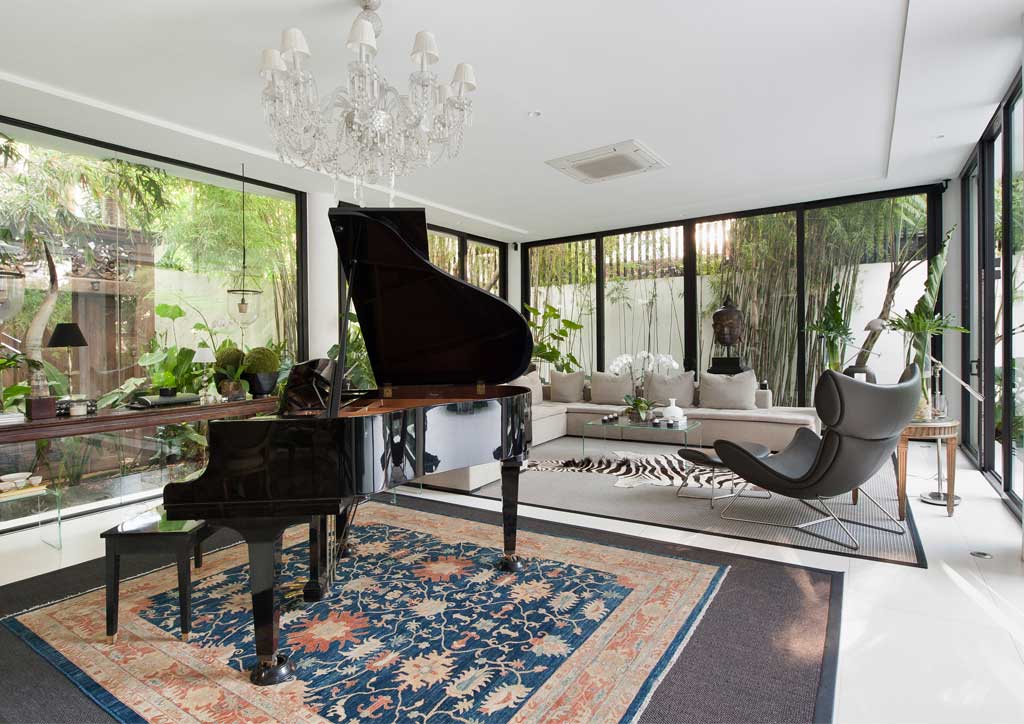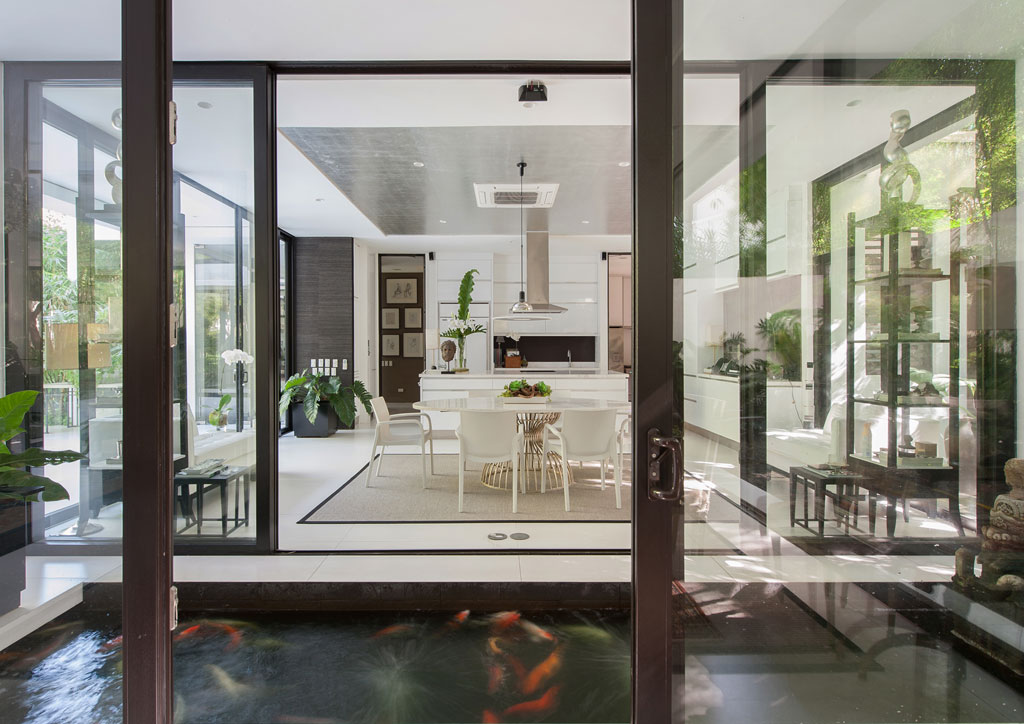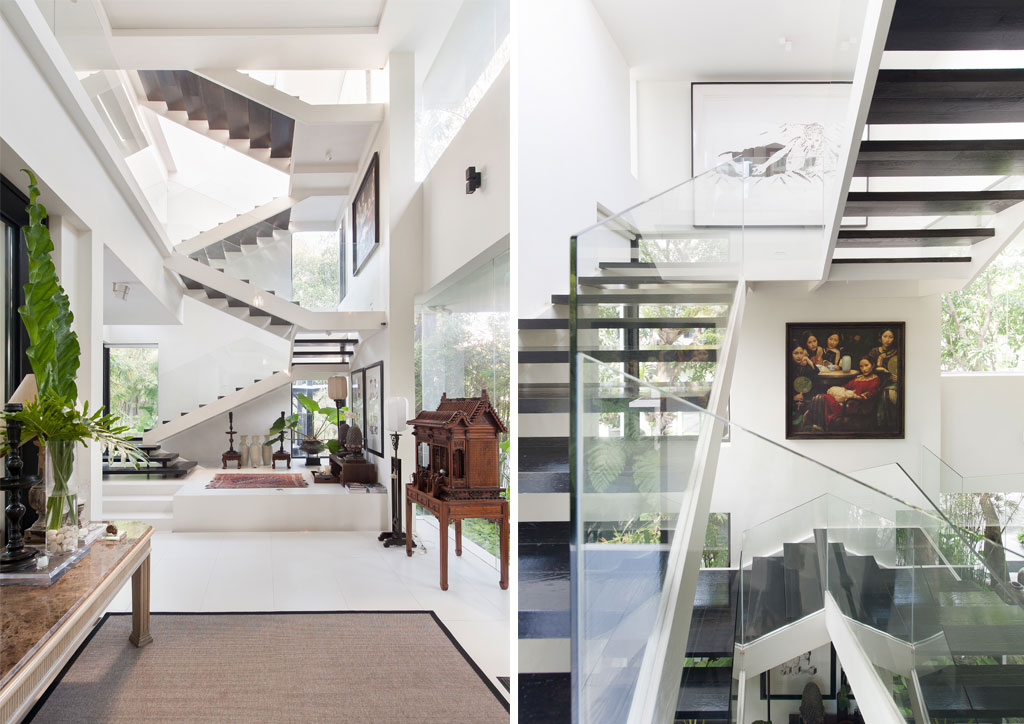
Modernism meets Asian resort in Conrad Onglao’s C House
Nestled in a quiet suburban neighborhood in Manila is an arboreal oasis whose white Modernist façade is screened by leafy greens, and whose main foyer opens out courageously—if not quietly—into the street. Completed in 2012 by architect and interior designer Conrad Onglao, the house, which Conrad calls the “C House,” sits in a snug 650-square meter lot that used to be the garden of an adjoining house. The owner decided to sell half of his lot, on the condition that the new owner retain the garden trees, which the owner himself planted in the Sixties. Conrad also trimmed and grafted the old bamboo grove at one corner to surround the house perimeter with foliage, increasing the sense of privacy, and refocusing on an “Asian resort” feel as a suitable counterpoint for his Modernist template of the house itself.
The house owners, a single parent with two children, wanted enough space for her children to entertain friends in intimate comfort after a lifetime of living in cramped condominium housing (first in the States and then here in Manila), with little privacy, and few opportunities to party. The conditions imposed by the new owner required Conrad to consider the family’s stylish comfort, privacy, and a sufficient space for the family members to entertain in style, and for the kids and their friends to “chill out” within easy visual reach, but without being disturbed or “confined.”

Despite the smallish lot, Conrad was able to harness 2,000 square meters of floor space for the owner by creating a four-storey footprint using a reverse pattern: instead of putting the sala and dining room in front that would have exposed his clients to unnecessary everyday noise and roaming pedestrians-cum peeping toms, he put it in the back of the ground floor facing the walled rear garden. The houseguests enter via a reception hall, which segues to the right into the main stairwell; out into the courtyard-lap pool area; and to the left into the powder room and short hallways to the clean kitchen-breakfast room.
READ MORE: Lor Calma’s abode debunks Nietzsche’s godless Modernism

Rather than confining house users to visually enclosed spaces by putting up opaque dividing walls, Conrad visually “opens up” these ground floor spaces facing the right-sided courtyard and lap pool area via the copious use of tempered curtain glass walls (three-quarters inch thick to withstand 250 kph gale winds). This was another design solution that allows the house to look less cramped and claustrophobic, and allows natural light to permeate throughout the ground floor spaces.
To allow even greater illumination and a heightened sense of ventilated space, he divided the structure between the courtyard-breakfast room and the rear sala-dining room by adding an air corridor planted by a koi pond between breakfast room-dining room; and an extension of the lap pool between the courtyard-sala, both spaces being provided with pathways to allow easy movement. Ventilation is also heightened by raising the ceiling heights of the rooms to 3.2 meters.

Ease of transportation between floors, and the convenience of being able to eat or entertain in the upper floors of the C House was also an important consideration. With this in mind, Conrad designed a scenic elevator that would allow guests—especially senior citizens and persons with disabilities—to access the two upper floors. Also, a dumb waiter lift was installed to haul food up, and remnants down, between a second floor mini-kitchen and the main kitchen downstairs. The second floor mini-kitchen looks out into the lap pool, with full-height sliding glass doors that may be opened to allow people out during emergencies. Off to one side of the mini-kitchen is the entertainment area that overlooks the reception hall via a balcony; and to the other side are the three bedrooms—including the master bedroom and walk-in closet/bath—that also face the rear side, just above the sala-dining room.
The third floor contains the garden roof deck, and a room pavilion that serves as a study and extended wardrobe for the house owner’s considerable dress collection, and a TV room/entertainment space. The underground basement, which is accessible via the dirty kitchen, contains more storage space for the house owner’s children, the exercise gym, as well as the servants and driver’s quarters. The three car-garage is in a defile just off the street and to the front side of the lap pool, in an open shed that would allow the driver to simply park a few meters away from the front door.
READ MORE: Tropical Mid-Century Ranch: House Number 17

Three things come to mind when Conrad designed the interior spaces and amenities of the C House: comfort, serenity and adaptability. Unlike other “star” architects, Conrad is not averse to mixing motifs within interiors as part of a “signature style.”
“I prefer designing houses that feel like they are actually lived in, not some sterile museum that people hardly use. So I allow the character and identity of the house owner to partially define the look and feel of the interiors and exteriors. For example, the owner had a vast collection of antiques, like these massive wooden double doors and framed lintels from Bali. Instead of integrating them into the structure itself, I decided to place them like cosmic portals facing the perimeter walls of the house. I also placed Buddha statues from the collection either in front of these doors, or on nooks like in the wall behind the reception hall. Although I designed the house in a general Modernist palette of whites with wood and raffia accents, I tailored some of the finishes to suit the owner’s pieces, like the ceilings of the main kitchen and dining room are finished in silver leaf to highlight the set of antique French silver furniture in the dining room.”
Classical referents, like Venetian stucco finish, are utilized in the courtyard to create a sense of simplified grandeur, here accented by Ann Pamintuan’s functional sculpture by the lap pool. Besides the scenic elevator, the hardwood treaded steps in the staircase are measured for a gentle rise to give users an easier time to ascend between floors.

Surrounded by the sumptuous Chinese celadon collection of the owner in its interiors, as well as artworks by Anita Magsaysay-Ho and Elmer Borlongan, Conrad Onglao’s C House is both a restatement of the owner’s rich heritage and needs for comfort and privacy; and the architect/interior designer’s wish for serenity and meditative peace that is possible in a garden setting, where intimate parties mingle peacefully with the private lives of its users.



